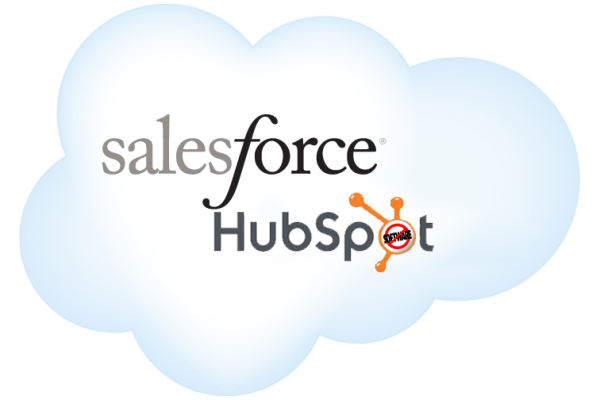Becoming an Inbound Sales Ninja: My 3 years growing with IMPACT and HubSpot Sales Hub
How did two guys with no particular background in sales lead a movement that doubled their firm’s revenue from one year to the next? How did they — with invaluable assistance from a team of like-minded sales reps that were recruited to join them — go about the daunting challenge of devising a repeatable, customer-centric process for converting inbound leads into new paying customers?
And most importantly, how can you get the same results (or better) at your business?
This is the story of my time at IMPACT. IMPACT is now recognized as one of the biggest names in inbound marketing, but when I joined January of 2017, it was a scrappy team of about 30.
By December 2017, after immersing ourselves for a year in HubSpot Sales Hub, we saw our best services month ever at IMPACT. We brought in $382,259, thanks in part to 10 new deals we made that month. We had doubled our annual revenue, and would do so again for the following year.
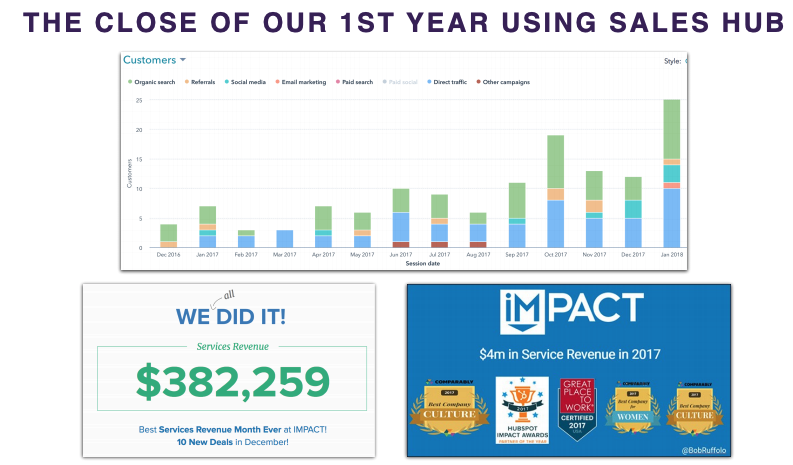
We succeeded at IMPACT by systematically rethinking how we handled the high-quality inbound leads our phenomenal content marketing efforts had netted us. We went all-in on the inbound sales methodology, and we committed to using HubSpot Sales Hub to its fullest extent.
You can do the same at your business.
Through some trial and error and a willingness to take chances, and by investing in a growing sales team empowered by the right tools and software, we charted a roadmap to inbound sales success. I’m going to share that roadmap with you in this article.
Technically, my title at IMPACT was Principal Customer Success Manager. But I’m more proud of what I became in the process of helping transform IMPACT’s sales organization: an inbound sales ninja. If you listen well, you could be on the path to becoming one too.
What Is an Inbound Sales Ninja?
When I presented a version of what you’ll read in this article at INBOUND18, I titled it, “Become an Inbound Sales Ninja: One Team’s Ultimate Playbook for Success with HubSpot Sales Hub.”
(If you prefer listening to my voice over reading, you can access an audio recording and the slide deck from my presentation here.)
I wanted a title that would grab the attention of conference-goers. But I didn’t choose the words thoughtlessly.
I think “inbound sales ninja" aptly captures a critical skill set of the modern product marketer — namely, the ability to carry the customer-oriented, problem-solving, data-driven approach of the most effective marketing departments into the realm of sales. (And vice-versa, to bring on-the-ground sales knowledge back to the marketing department.)
My favorite definition of inbound sales comes from Tom DiScipio, a partner at IMPACT and my partner in my year of mastering HubSpot Sales Hub.
Tom called inbound selling “the art of guiding a prospect through a personalized buying journey on their terms while further educating and challenging them to make the best decision for them and their organization.”
As for ninja, well, ninjas are cool.
But ninjas also symbolize the expertise and level of execution that only comes from practice and meticulous preparation! A ninja’s weapons and techniques are hidden. When they do their job well, a ninja’s craft is unnoticeable...
In other words, if you follow the playbook I describe below, as we did at IMPACT, your customers won’t perceive themselves as moving through a pre-planned sales funnel. All they will notice is the personal touch and focused attention on their needs.
Where We Were in January 2017 (And Where You Might Be Now)
(Just a bit of context to help you understand the narrative that follows: IMPACT sells digital sales and marketing consulting services, as well as marketing implementation. In terms of average deal sizes, in 2017, the typical client was investing about $85,000 per year with IMPACT.)
At the time I joined IMPACT, the agency was reaping the benefits of a consistent investment in content and inbound marketing. The IMPACT team members are voracious content creators; everybody in the company publishes at least a few pieces a year.
But while the IMPACT inbound marketing engine was generating leads at a stunning rate, everything slowed to a crawl when it hit the sales stage.
At that time, Tom DiScipio was the only dedicated sales rep. Tom was so overwhelmed with new business inquiries that just to get on an exploratory call with him, you had to book him nearly two weeks in advance.
This was not a formula for making our prospects feel good about working with us. And IMPACT's leadership (including Tom) knew more help was needed.
In IMPACT’s defense, we were not alone in undervaluing our sales department. According to the best data available at the time (Hubspot’s State of Inbound Report), 22% of companies planned to spend $0 on sales training and technologies in the next year. Close to half planned to spend less than $5,000.
Why companies invest so little on enabling their sales teams is a problem worth drilling into. But that’s a topic for another post. My point here is to show you what can be possible if YOU are willing to make the investment in people and technology — and to do so now so you can reap the sales ninja rewards.
How Our Team Adopted the HubSpot CRM and Sales Hub
What follows is the inbound sales playbook Tom and I (and soon to be joined by a few other talented folks) perfected over a year of thinking, trying, and learning about inbound sales and HubSpot’s sales tools.
Our work centered on four business goals. Our overarching objective was to achieve each goal by adopting and mastering features of HubSpot Sales Hub.
I’ll describe each goal here, along with how we made it happen using HubSpot software.
And if you’re overwhelmed, don’t worry. My advice is to start small, implementing one or two regular uses for each feature until it forms a habit. After all, salespeople run on habit.
1. Centralize Information Tracking
We had a mantra at IMPACT: “If it’s not in the CRM, it doesn’t exist.” The idea is that anyone, at any point in the sales process, should have quick access to every bit of data we had concerning a prospect. (That went for inbound leads, as well as leads we got through referrals, at events, and so on.)
We attached everything we could to deal records in the HubSpot CRM and tagged relevant team members:
- Screen recordings from meetings.
- Documents and contracts from PandaDoc.
- Notes from calls.
So, for example, if you had a meeting coming up with a prospect, you could quickly call up a record of previous interactions with the company and pick up right where the last conversation left off.
We also used Sales Hub to create pipelines for everything we sold. This saved sales reps from having to update information in three or four different places. (No more spreadsheets!)
One of the enormous benefits of centralizing information is the ability to generate detailed reports from the data. These can be invaluable tools for analyzing and perfecting your sales process.
HubSpot includes some excellent default reports to start with on the Sales Professional Dashboard. At IMPACT, we used HubSpot’s reporting tools to:
- Track and manage “demand” for exploratory calls and new opportunities.
- Find out where our deals were coming from (inbound leads vs. outbound prospecting).
- Track how many deals we had in each pipeline stage.
- Coach and advise sales reps on feature adoption and process improvement.
- See how and which deal sources translated into the most revenue.
2. Standardize Processes
The Hollywood version of a salesperson flies by the seat of their pants, changing their messaging in the moment based on almost superhuman intuition. And some real-life, lone-wolf style salespeople are really that good. But for the rest of us who work on teams that need to work closely together and solve for scale, a well-documented, repeatable sales process can do wonders.
After participating in a couple hundred deals at IMPACT, it became clear to me that we were repeating the same messaging to our prospects and performing the same types of tasks time and time again. Every sales interaction we had — whether it led to a close or not — fell into one of just a few buckets.
So I documented our standard sales process, which for us included six basic steps. Then in HubSpot, Tom and I constructed pipeline deal stages that mirrored that process.
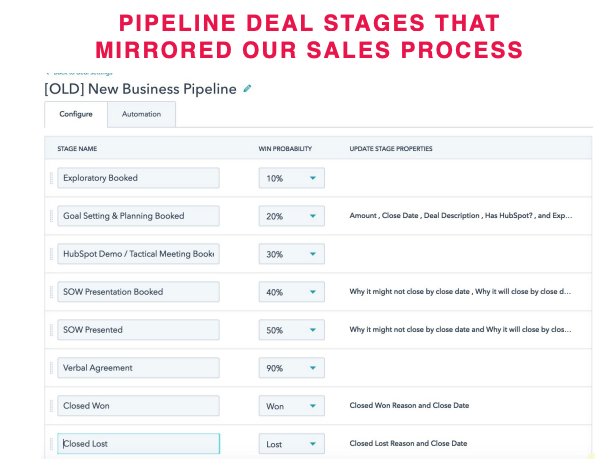
Because we had standardized our sales process and documented it in Sales Hub, I was able to identify opportunities to create templates (again in HubSpot) for common follow-up emails. This allowed me to reach out to prospects almost immediately after speaking with them. And it gave everyone at IMPACT a standard set of responses to draw on if they ever found themselves in a sales role.
That leads us to the next goal…
3. Increase Efficiency
It’s common sense (yet, backed by plenty of data) that the speedier your response to prospects, the more deals you’ll win.
Like most companies these days, at IMPACT, we had multiple ways for prospects to get in touch with us: contact forms, chat, email, phone, etc. We didn’t want to leave any potential new clients hanging, so we hired a lead manager (or “connection specialist”) to handle these initial contacts.
This was the single most valuable investment we made in the growth of our sales team. Myriah Anderson served as a gatekeeper. She would take 20-minute phone calls with new prospects, listen to their stories, decide if they had the potential to become a deal, and route them to the appropriate person (like me) for next steps.
And, of course, when it was my turn to speak to the prospect, I could quickly access Myriah’s call notes on the deal record, because everything was tracked through HubSpot.
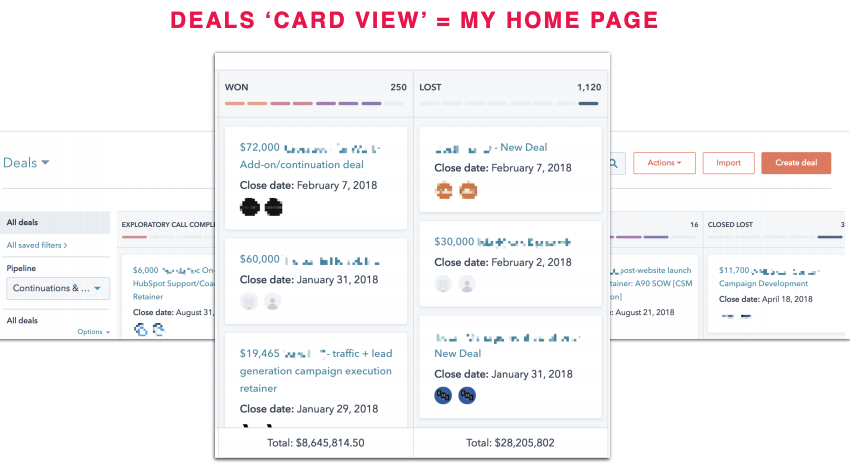
Other efficiency-boosting measures I took included:
- Making the Deals Pipeline “card view” in HubSpot Sales Hub my new homepage. This helped me focus on my ultimate goal: to move deals through the standardized pipeline from the left (first contact) to the right (won).
- Setting up the self-service meeting booking tool in HubSpot. This allowed prospects to grab some time with me without any awkward back-and-forth.
- Working entirely in HubSpot, staying in the flow (and not jumping out to my overloaded email inbox or personal to-do list). I made HubSpot “Tasks” my second homepage, so I would always know what I had to do to keep the deals moving along.
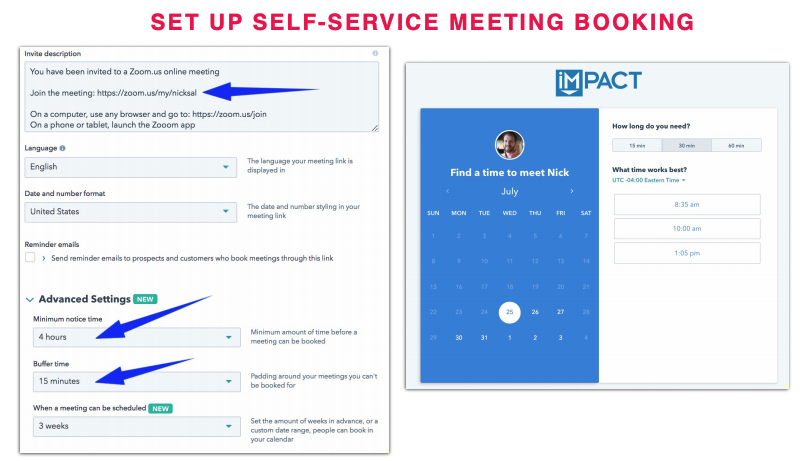
4. Extract Insights
By the end of 2017, the team at IMPACT had worked on over 200 deals. As you can imagine, by tracking everything in HubSpot, we had compiled quite a mountain of data to analyze and use to improve our sales process.
One of the most useful pieces of information we had for each deal was the “mini-debrief” we wrote up each time we closed a deal, won or lost. There was always something to learn from each sales interaction.
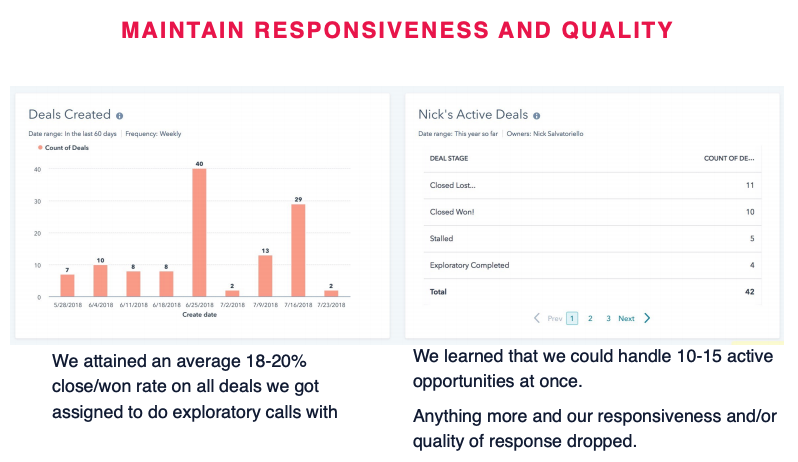
Some of the important lessons we learned by analyzing our sales data in HubSpot Sales Hub were:
- We attained an average 18% to 20% close/won rate on all deals that involved an exploratory call. That might seem low to some. But given that we tracked/counted deals from the initial explore call (instead of starting at the proposal/demo stage), and considering the volume of deals, we considered this pretty decent for year-one.
- It was taking us between 30 and 45 days to complete the sales process. We didn’t like seeing deals going longer than 30 days, but some of the best deals just took that long to iron out. We committed to make sure there was as little as possible on our end preventing unnecessary delays in next steps.
- We could handle between 10 and 15 highly-customized, detailed conversations with potential buyers at any given time (based on the average number of active deals in our pipelines and also my own experience). Any more than that (without an increase in efficiency) would lead to a drop in our responsiveness or the quality of our responses. So we put a new emphasis on adopting templates and looked for ways to productize our services further.
On top of looking at how we were doing on the process overall, we also took a look at the HubSpot dashboards that told us how many of its features and tools we were using as a team and individually. We wanted to make sure everyone was getting the efficiency boost they needed from HubSpot. And we wanted to identify opportunities to coach people on using the tools more effectively.
The Transformational Results of Our Playbook
Now comes the part where I talk about some of the changes we made after we got ourselves organized in HubSpot.
You may come to different conclusions in your organization because your data will be different. But my main point is, once you have the standardized sales process and the centralized information, you will be in an excellent position to make improvements to your sales efforts based not on intuition, but reality.
One problem we tackled was the length of time it took us to get to the close stage with our prospects.
Understandably, our prospects took a while to consider investing thousands of dollars in our services over several months. That’s a big leap to take with an unfamiliar partner.
So I suggested a new offering — what I call a “tripwire offer,” something you can carve off your product or service to offer as a short-term standalone project. In other words, a (paid) trial run. In our case, the offering was a two-week “mini-audit” along with a 90-day marketing strategy presentation (which served as the basis for our follow on proposal, if accepted).
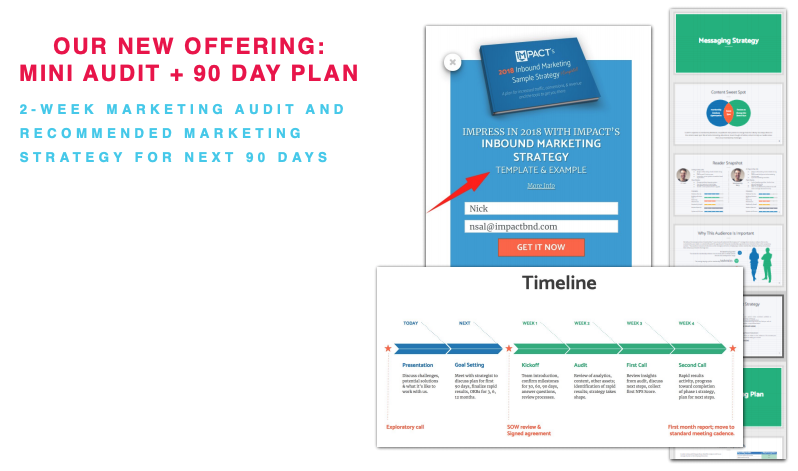
Our mini-audit offer was successful. Conversion rates climbed. But more importantly, prospects became more willing to make major commitments with us after they got to know us.
Another big adjustment we made was to refocus on customer success, not just before the sale, but throughout the entire customer relationship.
An inbound salesperson’s work isn’t finished when a deal is closed. You may have a services team that handles ongoing customer relationships, but really, customer success is everybody’s job.
I have made it a point to stay engaged with my former prospects after they transition to customers. I check-in to see how onboarding is going, make sure agreements are being honored, and discuss continuing, upgrading, or expanding the retainer.
When there’s a new service or new product available that might benefit a current customer, I’m right there, explaining its value.
This is a true inbound ninja move. (And I do recommend digging into the HubSpot Service Hub if you’re looking to close the circle of data between marketing, sales, and service.)
The Story Goes On
There’s more to the IMPACT story than I’ve shared here. The agency has continued to innovate and grow even as I have moved on to other roles with other agencies.
When I was still at IMPACT, we began to experiment with using video in the sales process, to great success. We also expanded our use of live chat.
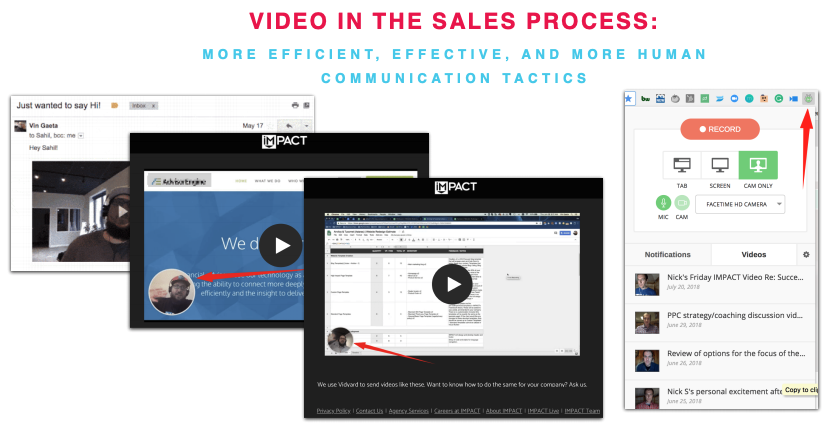
What I’m most impressed with about the team at IMPACT is that not only did they go on this nearly three-year journey of sales transformation with me, but they have sustained it.
That’s the hard part.
It’s fun to play around with new tools and explore new ways of using data in HubSpot. But it takes discipline to commit to a repeatable sales process. And it takes honesty and self-reflection to grapple with the implications of the data.
But I assure you, it’s worth it. Just look at what we achieved at IMPACT.
My time at IMPACT taught me that truly embracing the inbound methodology and tools means embracing them throughout your organization. Sales should not, and cannot, stand alone.
Believe it or not, what I’ve covered here only touches on the highlights of my INBOUND18 presentation. If you have 48 minutes available for advanced inbound sales ninja training, you can follow the whole story from start to finish on SoundCloud.
Are you building a team of inbound ninjas using HubSpot Sales Hub but don’t know where to start? Please feel free to reach out!

